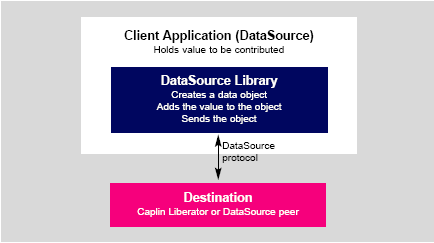|
DataSource for C SDK
7.1-10.29157-a18c1ca
|
 |
|
DataSource for C SDK
7.1-10.29157-a18c1ca
|
 |
A DataSource application performs two basic tasks:
The figure below shows how a DataSource applications fits into a real-time data system.

Your application contains values that need to be contributed. To be able to do this, DataSource SDK runtime libraries need to be included as a component within your application.
In order to contribute these values, you need to use the C functions provided by the DataSource library to create a data object and add the values to the object or objects. The object can then be forwarded to where it needs to be, whether it is a Caplin Liberator for distribution over the Internet, or another DataSource for aggregation of data.
A broadcast DataSource is the simplest type of DataSource. It sends all object and updates to all connected peers. If a broadcast DataSource is chosen then when an update is received from the data provider a simple process can be followed to send this data on to connected peers
An active DataSource accepts requests for objects, keeps track of which objects have been requested and only sends updates for those objects. Objects may be discarded as well as requested. Discarding is when a connected peer tells DataSource that it no longer wishes to receive updates for this object. Request and discard messages are tracked using your implementation of the ds5_dataprovider_t interface.
The following steps should be followed to provide data using an active DataSource: